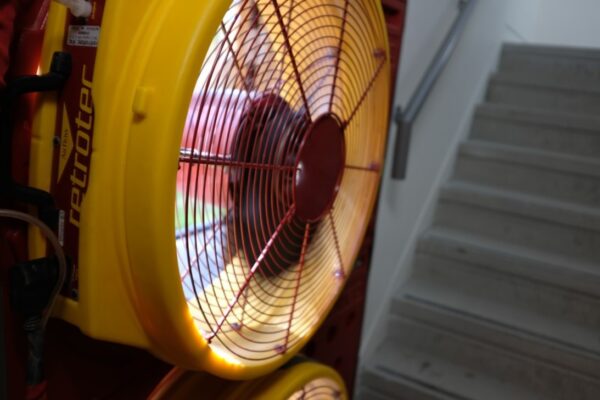Our Air Tightness Testing Procedure
Client’s often ask how we undertake the onsite air tightness testing. The air tightness test is undertaken in-line with Part L and the ATTMA standard. The pressure differential is measured across the envelope of the building by means of the temporarily installation of a large fan inside a door panel. Thereafter, a range of static pressures and environmental readings are taken. The fan is switched on and the air pressure in the property is gradually increased or decreased and the differential pressure is recorded at each step. The total air flow required to achieve a pressure differential of 50 Pa is calculated and divided by the total building envelope area to provide the leakage rate in m3/h.m2@50Pa.
Our air tightness test procedure is as follows:
- Firstly we walk around the building to make sure its been prepared inline with our air tightness checklist.
- We find a suitable doorway to temporarily install our blower door fan system (depending on building size.
- We then undertake the first series of environmental measurements such as internal and external temperatures as well as barometric pressures and internal and external temperatures.
- We then turn on the fan equipment and take measurements between 25-70Pa in 5Pa increments, recording the pressure differential at each step.
- Once the pressures have been taken we undertake the second set of environmental measurements.
- Finally, our technicians will calculate the total air flow required to achieve a pressure differential of 50 Pa, divided by the total building envelope area – this calculation will show leakage rate in m³/h.m² @ 50 Pa.
- We then undertake the second series of environmental measurements such as internal and external temperatures as well as barometric pressures and internal and external temperatures.
- Once the building air leakage rate has been established, if its passed the test, that test will be finished; however, if its failed we then pressurise the building (blows air into) to around 50 pascals of pressure. This forces air to flow through cracks or air leakage paths throughout the building envelope.
- We then turn on the smoke machine and walk around the house or commercial building, highlighting, and recording all the air leakage paths through the building envelope.
- A smoke test report will be produced to hand over to the site team so targeted remedial sealing works can be undertaken.
We usually allow two to three hours to complete each air tightness smoke test; however, we can attend site all day if instructed. If you have the necessary manpower, it allows your operatives to seal all the necessary air leakage paths on the day of the test. If you are planning on undertaking remedial sealing works on the day of the test, your operatives will need to have mastic, expanding foam, draught excluders, plasterboard, grip fill and suitable safe access to undertake the sealing works.
Our competent air test engineers note the points of air leakage, examine the test data and send test results to the customer in a technical report. If the test fails, we inform clients on what to do to pass the air tightness test to meet the Part L Standards. This article goes into more detail about air tightness testing on projects throughout the UK.
Let us help you pass your air tightness test
Using our 20 years of air tightness testing experience, we can help you pass your test at the first attempt. All of our tests are carried out in accordance with Building Regulations Part L, and as we are a UKAS accredited testing company so you can be sure of the highest standards at all times.
We provide a friendly and helpful service, for all types of clients including large development companies to self-builders and much more, so you can rest assured we are able to deal with your needs effectively. We also provide a ‘last minute’ testing service were we provide testing and produce the air test report in under 24 hours. To help you prepare for your test please download our air tightness checklist.
For more information please phone us on 01525303905 or email us at info@aptsoundtesting.co.uk. alternatviely, please visit our website at www.aptsoundtesting.co.uk


